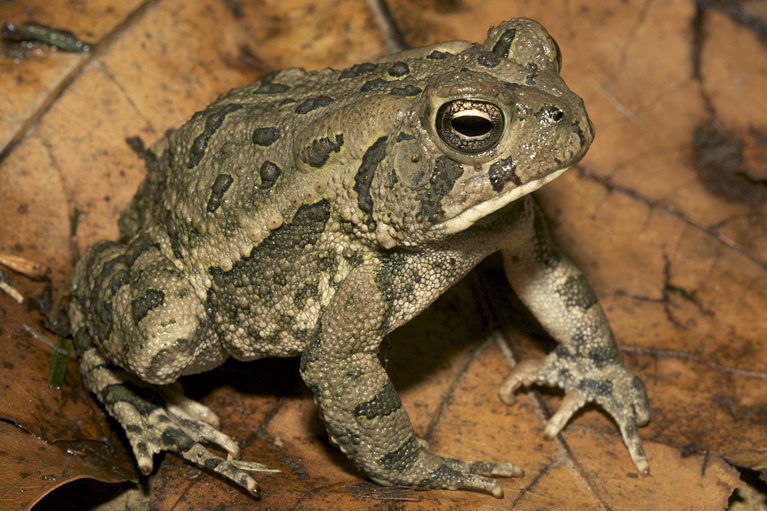Fowler’s Toad (Anaxyrus fowleri) is a small, stocky toad native to North America, primarily found in the eastern and central United States. It is often recognized by its distinctive markings and vocalizations. Here’s a detailed look at this interesting amphibian:
Key Features of Fowler’s Toad
1. Physical Appearance:
- Size: Fowler’s toads are relatively small, typically measuring between 2 to 4.5 inches (5 to 11.5 cm) in length.
- Coloration: Their coloration ranges from light gray to brown or olive, with darker spots and irregular blotches across their back.
- Skin Texture: The skin is rough and warty, typical of many toad species. They have pronounced parotoid glands located behind their eyes, which produce toxins as a defense mechanism.
- Eyes: They have prominent eyes with horizontal pupils, which help them see predators and prey in their environment.
- Identification: A distinguishing feature of Fowler’s toads is the three or more warts that occur within each dark spot on their backs.
2. Habitat:
- Preferred Environments: Fowler’s toads are typically found in a variety of habitats, including wooded areas, grasslands, fields, and wetlands. They are particularly associated with sandy or loose soils that allow for burrowing.
- Breeding Sites: They require shallow ponds, ditches, and temporary wetlands for breeding, often preferring areas with abundant vegetation.
3. Life Cycle:
- Breeding: Breeding usually occurs from late spring to early summer, triggered by warm temperatures and rainfall. Males call from the edges of ponds to attract females.
- Mating Call: The males produce a characteristic trumpet-like call, which is distinctive and can be heard from a distance.
- Eggs: Females lay strings of eggs in shallow water, typically in clumps attached to vegetation. A single female can lay several thousand eggs at one time.
- Tadpoles: The eggs hatch into tadpoles within a week or two. Tadpoles are generally dark and can develop rapidly, particularly in temporary ponds that may dry up.
- Metamorphosis: Tadpoles undergo metamorphosis after about 6 to 10 weeks, turning into juvenile toads, which then disperse into the surrounding habitat.
- Terrestrial Life: After metamorphosis, young toads begin to live on land, seeking shelter and food as they grow into adults.
4. Behavior:
- Nocturnal Activity: Fowler’s toads are primarily nocturnal, emerging at night to forage for food. They may be active during the day, especially after rains.
- Burrowing Behavior: These toads are adept at burrowing into the ground to escape heat and dryness, using their strong limbs to dig into loose soil.
- Social Behavior: Fowler’s toads can often be found in groups during the breeding season, congregating around suitable ponds and wetlands.
5. Diet:
- Carnivorous: Fowler’s toads are insectivorous, feeding primarily on a variety of invertebrates. Their diet includes:
- Beetles
- Ants
- Grasshoppers
- Caterpillars
- Spiders
- Foraging Technique: They use their sticky tongues to catch prey quickly. They may also forage actively, searching for food on the ground.
6. Defense Mechanisms:
- Toxic Skin: Fowler’s toads have skin glands that secrete toxins, which can deter potential predators. While these toxins are not harmful to humans, they can cause mild irritation if handled.
- Camouflage: Their mottled coloration helps them blend into their surroundings, providing some protection from predators like birds and mammals.
7. Lifespan:
- Fowler’s toads can live up to 10 years in the wild, although many do not survive due to predation and environmental pressures.
8. Conservation Status:
- IUCN Red List: Fowler’s toad is currently listed as Least Concern globally, but populations are affected by habitat loss and environmental changes.
- Threats: Primary threats to Fowler’s toads include:
- Habitat destruction due to urbanization and agriculture.
- Pollution from pesticides and chemicals that contaminate their breeding sites.
- Climate change, which affects the availability of suitable habitats and alters breeding patterns.
- Conservation Efforts: Efforts are being made to protect their habitats and monitor populations in areas where they are declining.
9. Adaptations:
- Adaptation to Moisture: Fowler’s toads are well-adapted to live in environments that can fluctuate between wet and dry conditions, which is vital for their breeding cycle.
- Rapid Development: Their ability to grow quickly from tadpole to adult helps them survive in temporary ponds that may dry up.
10. Interesting Facts:
- Vocalization: The distinctive call of Fowler’s toads is often associated with warm summer nights in areas where they breed. The call can be heard as a “waaaah” sound, which is particularly loud during mating season.
- Common Name Origin: The species is named after Samuel Fowler, a 19th-century American naturalist who contributed to the study of North American amphibians.
- Distribution: Fowler’s toads have a broad range, being found from southern Ontario and Quebec to Florida and westward to Texas and Kansas.
11. Threats:
- Habitat Loss: Urban development, agriculture, and deforestation are significant threats to their habitat.
- Pollution: Pesticides and fertilizers can contaminate their breeding ponds, affecting both tadpoles and adult toads.
- Climate Change: Changes in temperature and precipitation patterns can impact their breeding success and habitat availability.
Fowler’s Toad is a remarkable amphibian with unique adaptations that allow it to thrive in varied environments. Ongoing conservation efforts are vital to ensure the survival of this species in the face of habitat loss and environmental changes.
